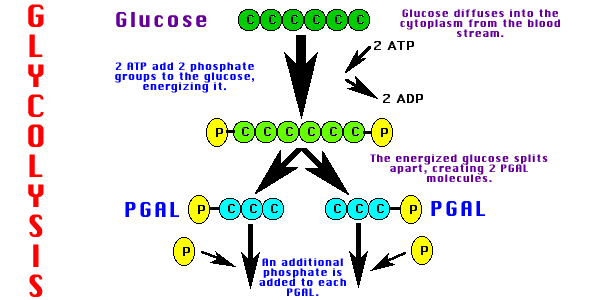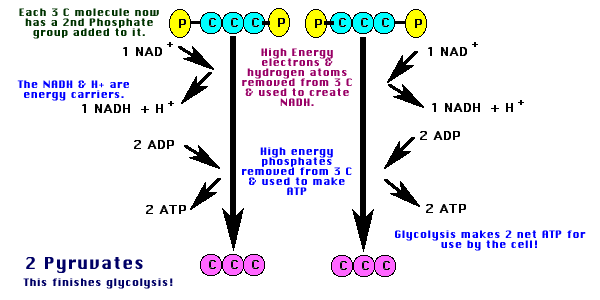In the presence of O2, glucose is completely broken down, yielding 36 net ATP for use by the cell.
![]()
Aerobic Respiration consists of 3 Main Steps:
1. Glycolysis (Anaerobic - No O2 needed)
2. Krebs Cycle (Aerobic - O2 needed)
3. Electron Transport (Aerobic - O2 needed)
| Aerobic Respiration Step | Location | # of ATP Made | Function |
|---|---|---|---|
| #1) Glycolysis | Cytoplasm |
4 gross, 2 net ATP |
Begins breakdown of Glucose. Converts glucose energy to ATP & NADH. |
| #2) Krebs Cycle | Matrix |
2 ATP |
Finishes breakdown of Glucose. Converts glucose energy to ATP, NADH & FADH2. |
| #3) Electron Transport | Cristae |
32 ATP |
Converts energy in NADH & FADH2 to ATP. |
Glycolysis is the first series of reactions that break glucose apart to liberate the energy it holds in its covalent chemical bonds. Glycolysis occurs in both aerobic and anerobic respiration!
Glycolysis basically:
a) splits Glucose (6 C) to make two 3-carbon molecules. 2 ATP needed to split glucose.
b) removes energy and hydrogen from the 3-carbon molecules. This is used to make NADH (E. carrier).
c) removes more energy to make 4 ATP. 2 ATP go to split next glucose. 2 ATP available for cell use.
d) At end of glycolysis, 2 pyruvate molecules (3C) left.


|
Summary of Glycolysis
|
| 1. One glucose (6C) converted into 2 pyruvates (3C). |
| 2. Net yield of 2 ATP for use by cell. |
| 3. Two NAD+ are converted into 2 NADH & 2H+. (These go to Electron Transport.) |
[Anaerobic Respiration (Fermentation)] [Aerobic Respiration]